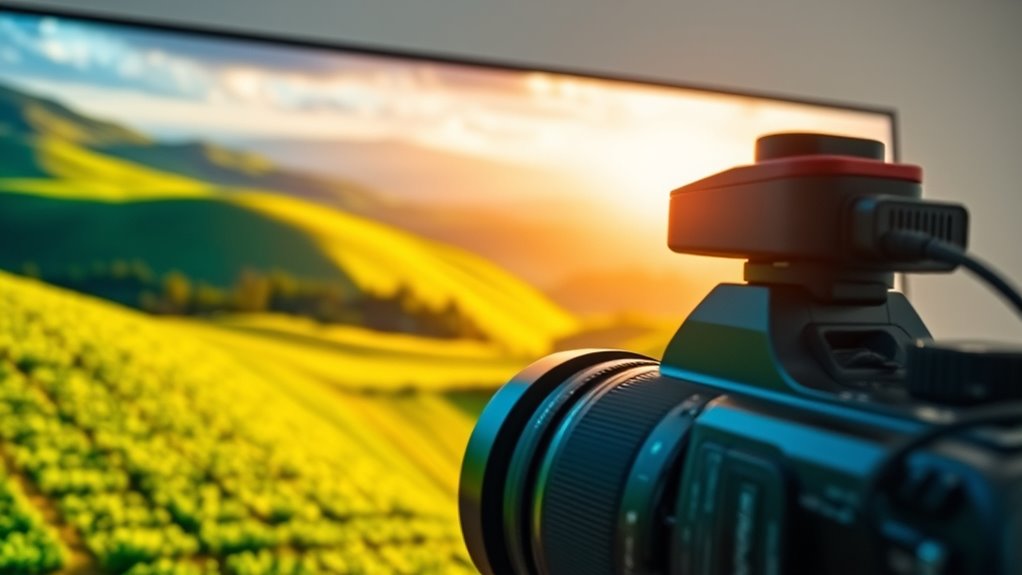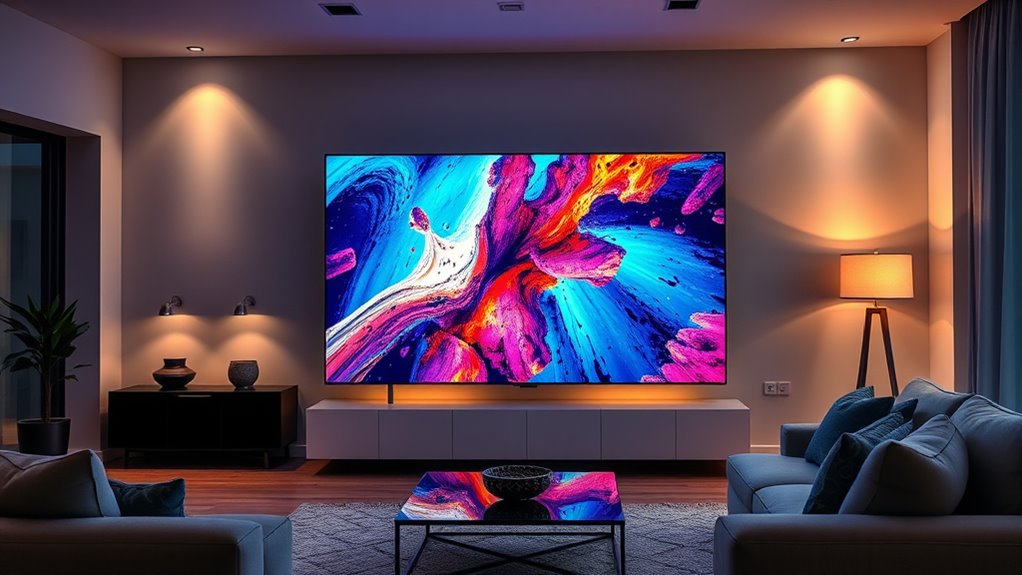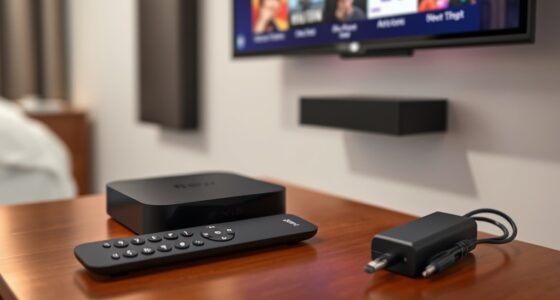Understanding streaming video formats like 4K, HDR, Dolby Vision, and more helps you get the best viewing experience. 4K offers sharper images, while HDR and Dolby Vision improve color, contrast, and brightness for a more vibrant picture. These formats also enhance efficiency through compression technologies like HEVC and AV1, ensuring smoother playback. By knowing how they work and are supported across devices, you can make smarter choices for higher-quality streams—continue to explore how these standards shape your viewing options.
Key Takeaways
- Streaming video formats like 4K, HDR, Dolby Vision, HEVC, and AV1 determine video quality, compression efficiency, and device compatibility.
- 4K resolution offers sharper images with four times the pixels of HD but requires higher bandwidth and compatible devices.
- HDR and Dolby Vision enhance color accuracy, contrast, and brightness for more vivid and immersive viewing experiences.
- Advanced formats such as HEVC and AV1 enable high-quality streaming at lower bandwidths, supporting 4K and HDR content.
- Staying informed about streaming standards helps optimize device choices, internet plans, and content quality for the best viewing experience.

Streaming video formats are the backbone of how we watch content online, ensuring videos load quickly and play smoothly across devices. When you hit play on your favorite show or movie, those formats work behind the scenes to deliver high-quality visuals without buffering or delays. They determine how the video data is compressed, transmitted, and rendered on your screen. Understanding these formats helps you get the most out of your viewing experience, especially as content quality continues to improve.
One of the most popular advancements is 4K resolution, which offers four times the pixels of standard HD. When you stream in 4K, you’re getting sharper images, more detailed textures, and a more immersive experience. However, to enjoy 4K, your device and internet connection need to support higher bandwidths. Not all streaming services default to 4K, so you might have to select this option manually. Keep in mind that streaming in 4K consumes more data, so if your internet plan has limitations, you’ll want to weigh that. Additionally, compression formats like HEVC and AV1 are designed to optimize quality while reducing bandwidth usage, making high-resolution streaming more accessible. These formats also influence the compatibility of various devices with high-quality streams. As technology advances, newer formats will continue to emerge, pushing the boundaries of what streaming can deliver. Staying informed about streaming standards can help you better understand the evolving landscape of digital viewing.
Beyond resolution and HDR, there are other formats like HEVC (H.265) and AV1 designed to improve compression efficiency. These formats enable streaming at higher qualities while using less bandwidth, making 4K and HDR streaming more accessible to a broader audience. As technology advances, newer formats will continue to emerge, pushing the boundaries of what streaming can deliver. Additionally, understanding content formats can help you optimize your viewing setup and ensure compatibility across devices. Recognizing the technological advancements in streaming formats can also guide you in selecting the right devices and subscriptions. In the end, understanding these formats helps you make informed choices about your devices, internet plans, and streaming services, ensuring you get the best possible picture quality every time you press play.
Frequently Asked Questions
How Do I Choose the Best Streaming Format for My Device?
When choosing the best streaming format for your device, consider its capabilities and your internet speed. If your device supports 4K and HDR, opt for those for better picture quality. Confirm your internet connection is fast enough to handle higher resolutions without buffering. Check the streaming service’s compatibility with your device. Ultimately, pick a format that balances quality and smooth streaming based on your device’s specs and your internet connection.
Are There Compatibility Issues With Older TVS and New Formats?
Your old TV might feel like a relic from a bygone era, but compatibility issues with new streaming formats are real. Many older models lack the necessary HDMI ports, processing power, or display technology to support 4K, HDR, or Dolby Vision. You could experience dull colors, lower resolution, or no picture at all. To enjoy modern streaming, consider upgrading your TV or using external devices that bridge the technology gap.
How Does Internet Speed Affect Streaming Quality?
Your internet speed directly impacts your streaming quality. If your connection is slow, you might experience buffering, lower resolution, or dropped quality altogether. For smooth, high-definition streaming, you generally need at least 25 Mbps for 4K content. Faster speeds guarantee better picture clarity, fewer interruptions, and a seamless viewing experience. So, upgrading your internet plan can substantially improve how well your videos look and play without interruptions.
Can I Upgrade Streaming Quality Without Changing Devices?
You can upgrade your streaming quality without changing devices by adjusting your streaming settings. Most platforms let you select higher quality options like 4K or HDR in the playback menu. Make sure your internet connection is fast enough to support these formats; otherwise, your stream may auto-adjust to lower quality. Upgrading your plan or optimizing your Wi-Fi can also improve your viewing experience without needing new hardware.
What Are the Environmental Impacts of Streaming High-Resolution Videos?
You might think streaming high-res videos has no environmental impact, but it does. High-resolution streams consume more energy due to larger data transfers and increased server load. This leads to higher electricity use, often from fossil fuels, contributing to greenhouse gases. So, while you get better quality, you’re also increasing your carbon footprint. To help, consider lowering resolution or downloading content for offline viewing to reduce environmental effects.
Conclusion
Now that you know the ins and outs of streaming video formats, you’re equipped to pick the perfect setup for your viewing needs. Think of it like choosing the right paintbrush for a masterpiece—you get to craft a stunning visual experience. Whether it’s 4K, HDR, or Dolby Vision, understanding these formats helps you access brighter colors, sharper images, and richer details. So go ahead, enjoy your movie nights armed with this new knowledge—your screen will thank you!















